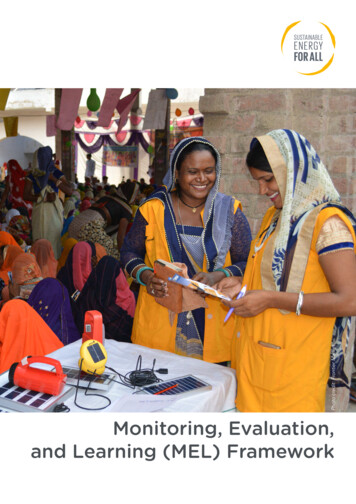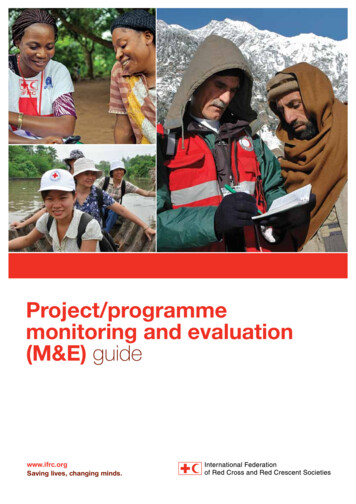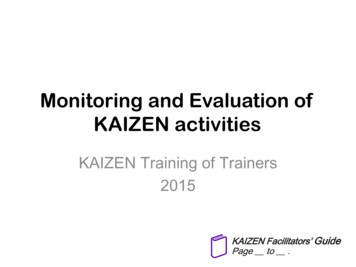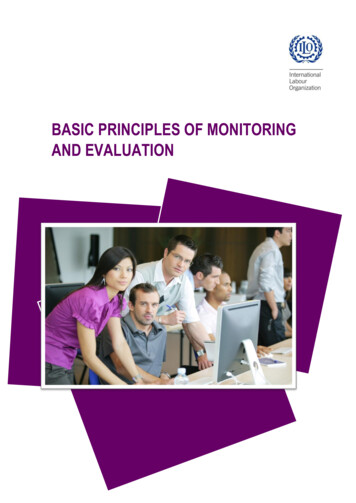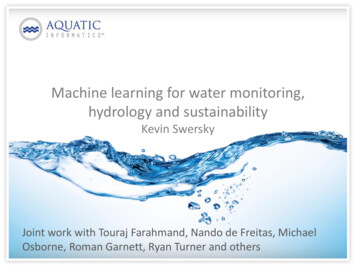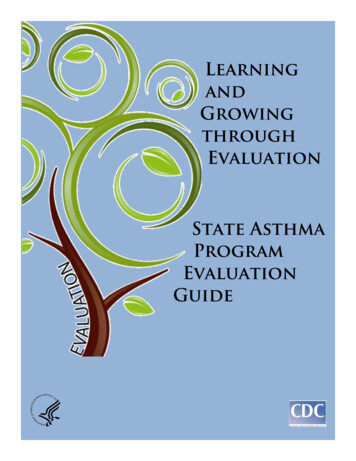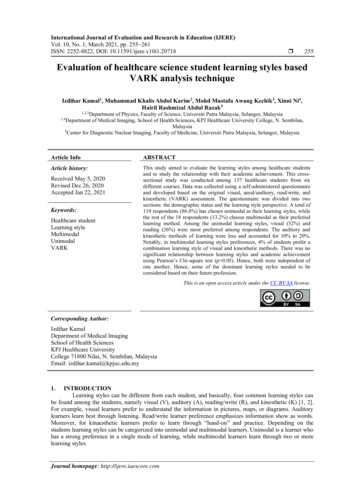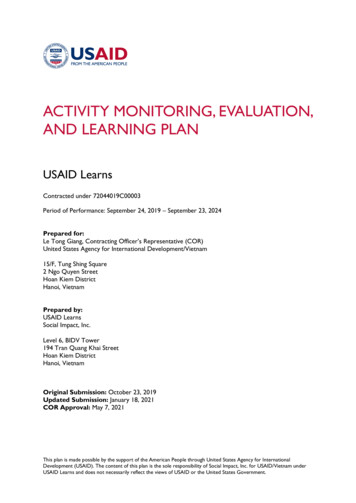
Transcription
ACTIVITY MONITORING, EVALUATION,AND LEARNING PLANUSAID LearnsContracted under 72044019C00003Period of Performance: September 24, 2019 – September 23, 2024Prepared for:Le Tong Giang, Contracting Officer’s Representative (COR)United States Agency for International Development/Vietnam15/F, Tung Shing Square2 Ngo Quyen StreetHoan Kiem DistrictHanoi, VietnamPrepared by:USAID LearnsSocial Impact, Inc.Level 6, BIDV Tower194 Tran Quang Khai StreetHoan Kiem DistrictHanoi, VietnamOriginal Submission: October 23, 2019Updated Submission: January 18, 2021COR Approval: May 7, 2021This plan is made possible by the support of the American People through United States Agency for InternationalDevelopment (USAID). The content of this plan is the sole responsibility of Social Impact, Inc. for USAID/Vietnam underUSAID Learns and does not necessarily reflect the views of USAID or the United States Government.
CONTENTSAcronyms .iiIntroduction .1About Learns .2Activity Purpose . 2Connection to USAID Priorities . 2Theory of Change.3Context . 3Logic Model & Theory of Change . 3Risks/Threats, and Assumptions/Enabling Conditions . 7Learning Priorities .9Learning Questions . 9Learning Activities . 10Performance Monitoring . 12Context Monitoring. 13Evaluation . 13Learning . 14Knowledge Management .15Data Collection & Learning Methods . 15Data Storage . 16Data Quality . 16Data Analysis. 16Knowledge Application. 16Reporting . 16Roles and Responsibilities .17Estimated Resources . 17Schedule . 18Change Log .19Annex I: Performance Indicator Tracking Table .24Annex II: Performance Indicator Reference Sheets (PIRS) .26LIST OF FIGURES AND TABLESFigure 1: Learns Objectives and Outcome Indicators . 4Figure 2: Journey to Evidence-Informed Decision-Making. 5Figure 3: Logic Model for Learns, Representing the Theory of Change . 7Table 1: Threats and Mitigation Strategies . 8Table 2: Learning Questions and Corresponding Learning Activities. 10Table 3: Learns Performance Indicators . 12Table 4: Example of Contribution Tracking in Practice . 13Table 5: Proposed Evaluation. 14Table 6: Data Collection & Learning Methods . 15Table 7: Schedule for Tracking Learning . 18Table 8: AMELP Change Log . 19Table 9: Changes to Performance Indicators – April 2020 . 21Table 10: Changes to Performance Indicators – January 2021. 22Table 11: Performance Indicator Tracking Table. 24i AMELPUSAID LEARNSUSAID/VIETNAM
IDUSDii AMELPUSAID LEARNSAfter Action ReviewAutomated Directives SystemActivity Monitoring, Evaluation, and Learning PlanCountry Development Cooperation StrategyCollaborating, Learning & AdaptingChief of PartyContracting Officer’s RepresentativeDeputy Chief of PartyDevelopment Information SolutionData Quality AssessmentFiscal YearGovernment of VietnamImplementing PartnerIndo-Pacific StrategyJourney to Self-RelianceLearning QuestionMonitoring and EvaluationMonitoring, Evaluating, and LearningNet Promoter ScoreOperating UnitProgram Development OfficePerformance Indicator Reference SheetPerformance Indicator Tracking TablePerformance Management PlanQuick ResponseTechnical AssistanceTo Be DeterminedTraining and Exchange Automated Management SystemSocial Impact, Inc.United States Agency for International DevelopmentUnited States DollarUSAID/VIETNAM
INTRODUCTIONThe United States Agency for International Development (USAID)/Vietnam Learns activitymonitoring, evaluation, and learning plan (AMELP) clarifies the team’s approach to monitoring,evaluation, and learning (MEL).Learns’ implementation is guided by a logic model and theory of change outlined beginning on page 3that was updated in April 2020. The MEL approaches, priorities, and performance indicators in thisplan flow from this logic model and theory of change and are outlined in detail below. In line withAutomated Directives System (ADS) 201, this AMELP specifies: anticipated results under the activity;methods by which Learns will:o track progress towards results,o learn from implementation,o adapt implementation based on learning,o share its learning with key stakeholders; and,resource requirements and internal roles and responsibilities for MEL.Learns has dedicated resources to operationalize this AMELP through its budget, including the laborcategories which fund the Learns staff responsible for implementing this plan. A specific Learns staffmember is responsible for each indicator and data collection approach, and for reporting results toUSAID/Vietnam annually, semi-annually, or quarterly, depending on the indicator.Updates to this plan will be provided to the Contracting Officer’s Representative (COR) for reviewand approval on an annual basis every September in line with work planning or when revisions to theplan are proposed.The Learns team hopes that this AMELP can serve as an example for USAID/Vietnam’s implementingpartners (IPs). Learns is committed to modeling effective MEL and collaborating, learning, andadapting (CLA) practices for effective activity management with the understanding that each activity,including Learns, should view AMELPs as a management tool which should be continuously used andregularly updated to capture ongoing learning and changing environments.1 AMELPUSAID LEARNSUSAID/VIETNAM
ABOUT LEARNSACTIVITY PURPOSEAs stated in the Learns contract, the purpose of the activity is to improve the effectiveness andsustainability of USAID/Vietnam’s programs. Learns aims to achieve this by promoting collaborative,evidence-informed programming at USAID and its partners. Learns support covers the range ofUSAID Program Cycle processes, including strategy implementation, project design andmanagement, activity design and management, MEL, and CLA.The specific contract objectives are to:strengthen USAID/Vietnam, IPs, and local entities’ (Government of Vietnam [GVN], localorganizations) institutional capacity, particularly in monitoring, evaluation, learning,collaboration, and adaptive management, to achieve expected results.deepen use of monitoring, evaluation, and other types of data to support learning andimprove performance at all levels.improve coordination, collaboration, and learning between USAID/Vietnam staff, GVN, IPs,and key stakeholders.Given this scope, Learns works with multiple stakeholders, including USAID/Vietnam’s ProgramDevelopment Office (PDO), technical offices and other support offices, IPs (including internationaland local partners), and other local stakeholders.CONNECTION TO USAID PRIORITIESWhile Learns does not formally fall under a USAID project, the purpose of the activity is to supportUSAID staff and IPs across the Mission’s entire portfolio and contribute to the achievement of theMission’s updated strategy for 2020-2025. All offices across the Mission support Learns with a setbudget allocation and, in turn, Learns provides Program Cycle support to USAID staff and partners.In this way, Learns supports all projects by better integrating monitoring, evaluation, collaborating,learning, and adapting approaches that support better design and implementation and ultimatelybetter, more sustainable results as outlined in the logic model below.2 AMELPUSAID LEARNSUSAID/VIETNAM
THEORY OF CHANGECONTEXTUSAID/Vietnam has recently established a new Country Development Cooperation Strategy(CDCS) for 2020-2025, outlining its priorities for its development assistance in Vietnam. Toeffectively implement this strategy and manage towards results, the Mission has procured aninstitutional support contract (Learns) to act as a force multiplier for the Mission’s PDO. Learns staffand consultants provide ongoing technical assistance in Program Cycle processes (strategy, projectdesign and implementation; activity design and implementation; MEL; and CLA) and build the capacityof USAID and partners in said processes.The situation at the start of Learns (i.e., a snapshot of the current context) within the Mission andamong its IPs per Program Cycle level (strategy, project, and activity) can be considered as follows: Strategy design and implementation: As of April 2020, the CDCS awaits final approvalfrom USAID/Washington. The Mission needs support to:o communicate its new strategy within the Mission, among IPs, and to localstakeholders.o develop the Performance Management Plan (PMP) to track progress towardsstrategy-level results and support strategy-level learning and adapting.o reflect on implementation of the strategy and adapt the strategy as needed shouldthe context change or new learning emerge.o connect strategy to other USAID/Washington strategic priorities such as theJourney to Self-Reliance (J2SR) and the Indo-Pacific Strategy (IPS).Project design and implementation/management: With the eventual approval of theCDCS, the Mission will be working through many updates to existing project designs andnew project designs. The Mission needs support to:o develop project appraisal documents based on existing learning and in collaborationwith key stakeholders.o develop or review project MEL plans to track progress towards project-level resultsand support project-level learning and adapting.o institutionalize the role of the project manager for effective management of projects.Activity design and implementation: Similarly, with new project designs, the Missionanticipates the procurement of new mechanisms. The Mission needs support to:o design new activities, including through co-creation approaches with localstakeholders and IPs.o support USAID and IPs in government approval processes at the activity level.o build the capacity of IPs in MEL and CLA to better manage their awards.o provide support to MEL planning, data quality assessments (DQAs), and learning atthe activity level.LOGIC MODEL & THEORY OF CHANGEAgainst this backdrop, Learns supports USAID/Vietnam in its ultimate strategy-level goal of an“open, prosperous, and secure Vietnam that is effective and inclusive in tackling its own developmentchallenges.” This overarching Mission strategy-level goal has been simplified to read “Sustainable andlocally-owned development results achieved” for the purposes of demonstration in the center of Figure1. Learns does not have direct control in achieving this goal, but its work will contribute to it byfocusing on three interrelated activity objectives (the outer ring of Figure 1). The three objectives, asarticulated here, relate directly to key performance objectives 1, 2, and 3 in the contract.3 AMELPUSAID LEARNSUSAID/VIETNAM
Staff 1 knowledge and skills in MEL and CLA improvedEvidence 2 -informed decision-making advanced (Evidence Use Component)Strategic 3 collaboration between staff and local stakeholders strengthened (LocalEngagement Component)P0FPP1FP2FPPThese three objectives are inter-related; for example, capacity building in conducting DQAs or inMEL planning will result in better quality data being available to inform decision-making. Similarly,collaboration with local stakeholders will result in potentially new perspectives and evidence that caninform decision-making. Capacity building for USAID staff in co-creation can also strengthencollaboration between staff and local stakeholders.FIGURE 1: LEARNS OBJECTIVES AND OUTCOME INDICATORSStaff throughout refers to USAID and IP (including local partner) staff.Evidence refers to the broad base of knowledge that results from special studies, evaluations, monitoring data, learningevents, and reflective practice.3 The word strategic is used here to denote collaboration that is done with a specific purpose with the right people at theright time. Learns does not want to promote collaboration for the sake of collaboration.124 AMELPUSAID LEARNSUSAID/VIETNAM
To achieve results, how Learns implements its interventions to achieve these objectives is just as – if not more– important than the activities themselves. These three objectives will contribute to a sense of jointownership and commitment from target staff to integrate effective monitoring, evaluation, and CLAapproaches into their work if Learns approaches its work in the following ways:Capacity building interventions will:a. always begin with the “why” – why the topic of the capacity building effort (i.e.,Development Information Solution [DIS], DQAs, co-creation, CLA, etc.) isimportant and how it contributes to better development results to generate a senseof purpose in applying these approaches.b. be tailored to the capacity building needs of target staff.c. be designed based on good practices in adult learning.In line with Figure 2 below, evidence use interventions will:a. start with a clear understanding of use so that MEL activities are fit to purpose andtied to existing work processes (i.e., work planning) that enable use.b. be designed with those who will ultimately use the evidence to increase their buy-in.c. focus on the quality and credibility of data and information; low-quality data is notuseful to inform decision-making.d. communicate evidence and learning in easily accessible ways.e. be carried out by credible people that evidence-users trust to produce high-qualityevidence.f. provide opportunities for staff to internalize evidence, a critical and often missingcomponent of ensuring evidence gets used. 4g. promote a data use culture within the Mission and among IPs by establishing andsupporting habits that enable use.P3FPBelow: The journey to evidence-informed decision-making requires a clear process for getting to evidence-use,effective collaboration with evidence partners, and an understanding of how political, organizational, andindividual factors can influence whether evidence is ultimately used.FIGURE 2: JOURNEY TO EVIDENCE-INFORMED DECISION-MAKINGFor more on evidence-informed decision-making, see this resource on the Journey to Evidence-Informed DecisionMaking. Baker & Salib, USAID Learning Lab, 2017.45 AMELPUSAID LEARNSUSAID/VIETNAM
Local engagement interventions will:a. ensure collaboration is strategic rather than collaborating for the sake ofcollaboration (which has been shown to backfire 5 ). Being strategic aboutcollaboration means Learns will help USAID and IPs think through who they shouldbe collaborating with, why, and what form that collaboration should take.b. be well facilitated to ensure high participation, effective decision-making, andcommitment to next steps.P4FPAcross all three objectives, Learns will establish mechanisms to obtain feedback from target staff tocontinuously improve its approaches for better overall performance. This will also enable Learns toidentify strategic interventions (beyond USAID-requested tasks) based on feedback and Learns’experience supporting USAID that need to be incorporated into the Learns work plan.If Learns achieves its objectives as outlined above and risks/threats are mitigated (see more on thisbelow), then staff will have ownership of and be committed to improved Program Cycle processes.That ownership and commitment will contribute to staff behavior change: Staff, informed by evidence, continuously improve programming (both capacity building andevidence use interventions contribute to this intermediate outcome).Staff meaningfully engage local stakeholders in programming (both capacity building and localengagement interventions contribute to this intermediate outcome).USAID and IP staff are already making evidence-informed decisions and focusing on local engagement;Learns’ support is meant to contribute to staff doing this more systematically, intentionally, and withappropriate resources. Staff ultimately have control over their behavior; as such, we can create theconditions (via interventions under the three objectives) that enable greater ownership andcommitment from staff and, as a result, they take on these behaviors regularly and with intention.If staff continuously improve based on evidence and increase meaningful local engagement 6 inprogramming, they will contribute to the achievement of sustainable and locally-owned developmentresults (the ultimate goal of this activity and USAID/Vietnam more generally). Both continuousimprovement and local engagement are necessary to achieve more sustainable and locally-ownedresults in line with USAID/Vietnam’s strategy; only using evidence to continuously improve withoutmeaningful local engagement could result in technically sound programming that does not have localbuy-in. Local engagement without a strong evidence base for continuous improvement could resultin high buy-in, but programming that is not technically sound or reflective of the experiences of abroader spectrum of Vietnamese society.P5FPSee the activity logic model below that illustrates the above theory of change narrative. Here are thekey levels within the graphic: Activity Goal: Sustainable and locally-owned development results achieved. (center circle inthe graphic below)o Activity Purposes: Staff, informed by evidence, continuously improve programming &staff meaningfully engage local stakeholders in programming. (ring outside of centercircle) Activity Sub-Purpose: Staff/stakeholder ownership of and commitment toeffective Program Cycle processes increased. (ownership and commitmentring below) Activity Objectives: (outer ring)1. Staff knowledge and skills in MEL and CLA improved2. Evidence-informed decision-making advancedSee findings on collaboration on page 2. USAID, 2020.The link between local engagement and more locally owned development results is well-established. For more on thislinkage, see the 2018 CLA Case Competition Analysis (USAID, 2019, P. 20).566 AMELPUSAID LEARNSUSAID/VIETNAM
3. Collaboration between staff and local stakeholdersstrengthenedFIGURE 3: LOGIC MODEL FOR LEARNS, REPRESENTING THE THEORY OF CHANGERISKS/THREATS, AND ASSUMPTIONS/ENABLING CONDITIONSRisks/threats to establishing this sense of ownership and commitment among staff and subsequentintermediate outcomes include: Unsupportive leadership: If USAID, IP, and GVN leaders are not supportive of improvedMEL and CLA and Program Cycle processes more broadly, then there will not be sufficientinternal incentives for staff to change their behavior. As a result, Learns will not receive theattention and commitment of staff, leading to reduced levels of ownership and limitedachievements of results.Political considerations override learning and local engagement: As a United StatesGovernment (USG) agency, it is possible that political considerations from Washington orthe State Department take precedence over the evidence base or feedback from localstakeholders. When this happens, it can threaten staff motivation for effective MEL and CLApractices, reducing levels of ownership and limited achievement of results.7 AMELPUSAID LEARNSUSAID/VIETNAM
Learns is managed with a task-orientation (vs. a strategic orientation): If Learns is seenand used by USAID solely as a task completion contract, this will limit the contract’s abilityto see the big picture, understand context behind the technical work, and provide strategicinsight and support that could benefit USAID and its partners.TABLE 1: THREATS AND MITIGATION STRATEGIESThreatMitigation strategiesUnsupportive leadershipDiscuss challenges with COR to determine possible actions. For example,Learns and the COR may opt to focus energy on teams with better enablingconditions or may try and address barriers directly.Political considerationsoverride learning andlocal engagementLearns and the COR and other Activity Managers may identify where thereis flexibility to respond to evidence and local feedback despite thoseimportant political considerations. For example, perhaps what USAID has todo is pre-determined, but how they accomplish it may be more easilyinfluenced by evidence and local feedback.Task-orientation (vs. astrategic orientation)Frequent discussion with USAID to gain more context and identify value-addopportunities for Learns.Key assumptions include: Staff ultimately have control over their behavior; as such, we can create the conditions thatenable these behaviors, but ultimately, it is outside of Learns’ direct control as a contract.Staff are bought into the support Learns provides and are willing to be more intentional intheir implementation of the Program Cycle.In addition, the enabling conditions for success are important assumptions that, if notrealized, can negatively affect the achievement of results.o Learns will model a collaborative, learning-focused, and adaptive approach in how itmanages and delivers services and capacity building so that staff are fully bought-intoand committed to the approaches used.o There will be a high degree of trust between Learns and USAID and IPs based inmeeting expectations and buoyed by strong, healthy, and collaborative relationships.o There will be sufficient resources, including time, to ensure USAID and IP staff canengage with Learns and their respective stakeholders to carry out these ProgramCycle processes effectively.o USAID/Vietnam’s PDO treats Learns as an extension of the office to enable effectivecollaboration across a range of stakeholders: other USAID staff, IPs, and localstakeholders. This will enable USAID to make use of the full potential of Learns’support and ensure that Learns has the background and context to be mosteffective.8 AMELPUSAID LEARNSUSAID/VIETNAM
LEARNING PRIORITIESLEARNING QUESTIONSBased on the theory of change above, Learns will focus on MEL efforts to address learning questions(LQs) under three broad themes:Progress towards results:Question # 1: Is Learns achieving its intended results within the three components? If yes, what isenabling this? What is hindering the achievement of results?Question # 2: Is Learns’ approach engendering ownership and commitment among staff forimproved Program Cycle processes? Is that leading to continuous improvement and meaningful localengagement? If yes, what is enabling this? What is hindering the achievement of results?Question # 3: Has Learns’ support contributed to more sustainable and locally-owneddevelopment results? If so, how and under what conditions was this possible?Continuous improvement:Question # 4: Are there any unintended negative consequences as a result of Learns’ support? Ifso, what are they and how can they be mitigated?Question # 5: What are the perceptions of target staff (and Learns’ staff) about Learns’ support?Do they consider our support useful, effective, and efficient? In what ways can we improve inresponse to this feedback?Shifts in context:Question # 6: How are shifts in USAID/Washington and within USAID/Vietnam affecting our abilityto support the Mission and its IPs? What should we do in response to these shifts to ensurecontinued, positive results?9 AMELPUSAID LEARNSUSAID/VIETNAM
LEARNING ACTIVITIESThe questions under these three learning themes will be answered through various learning activities (MEL) described in greater detail below:TABLE 2: LEARNING QUESTIONS AND CORRESPONDING LEARNING ACTIVITIESProgress towards resultsLearning questionMonitoringEvaluationLearningUseQuestion # 1: Is Learns achieving its intended results withinthe three components? If yes, what is enabling this? What ishindering the achievement of results?Performance monitoringfocused on outcomelevel indicators percomponent (seemonitoring sectionbelow)N/AContribution tracking ofLearns’ contributions tohigher-level outcomes.Course correction ifanticipated results are notachieved; use success factorsand barriers to guideimplementation of futureactivities; report andcommunicate about Learns.N/ASuggestedperformanceevaluation orspecial studyContribution tracking ofLearns’ contributions tohigher-level outcomes.Inform approaches for futureUSAID, Social Impact, andother contractor-led supportmechanisms.Learning questionMonitoringEvaluationLearningUseQuestion # 4: Are there any negative consequences as aresult of Learns’ support? If so, what are they and how canthey be mitigated?N/AN/ABring awareness to potentialnegative impact and developmitigation strategies.Question # 5: What are the perceptions of target staff (andLearns’ staff) about Learns’ support? Do they consider oursupport useful, effective, and efficient? In what ways can weimprove in response to this feedback?Performance monitoring(net promoter score)N/AQualitative feedback fromUSAID Activity Managersat the end of majoractivities.Question # 2: Is Learns’ approach engendering ownershipand commitment among staff for improved Program Cycleprocesses? Is that leading to continuous improvement andmeaningful local engagement? If yes, what is enabling this?What is hindering the achievement of results?Question # 3: Has Learns’ support contributed to moresustainable and locally-owned development results? If so, howand under what conditions was this possible?Based on performancemonitoring data, Learnswill hold internal quarterlyreflections on its data &discuss enabling factorsand barriers.Continuous Improvement10 AMELPUSAID LEARNSAfter Action Review(AAR) for major activities.IP biannual meeting t
Annex I: Performance Indicator Tracking Table .24 Annex II: Performance Indicator Reference Sheets (PIRS).26 LIST OF FIGURES AND TABLES Figure 1: Learns . learning, and adapting approaches that support better design and implementation and ultimately better, more sust
